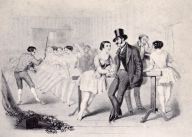 Backstage:
Privatization & Prostitution
Backstage:
Privatization & Prostitution
Earlier in these discussions, I made reference to two points upon which I would like to elaborate: one was the audience to whom these dancers performed night after night was predominantly male and the other was the privatization of the theatres. These two points go hand in hand, as I will demonstrate. The privatization of the theatres in both Paris and London caused these institutions to fall under financial strain. In an effort to counteract the lack of public funds, owners and managers came under increased pressure to sell private subscriptions. To increase these sales and attract the patronage (and wallets) of wealthy businessmen, both the Covent Garden Opera Ballet and the Paris Opera opened private spaces where prosperous patrons could “mingle” with the corps de ballet (or ballet rats, as they were often referred to as) (Soloman-Godeau 1986). These spaces transformed the backstage of these theatres into bordellos, the private playgrounds of the affluent bourgeoisie. So when Janin remarked that “nothing is more bachelorlike [sic] than the public” (Chapman 1997, p. 214), he was not speaking strictly in metaphor. This privatization and prostitutionalization of the ballet dancer contributed to the expulsion of the danseur from the theatres. Middle-class male patrons wanted nothing to disturb the private harem to which they had access.